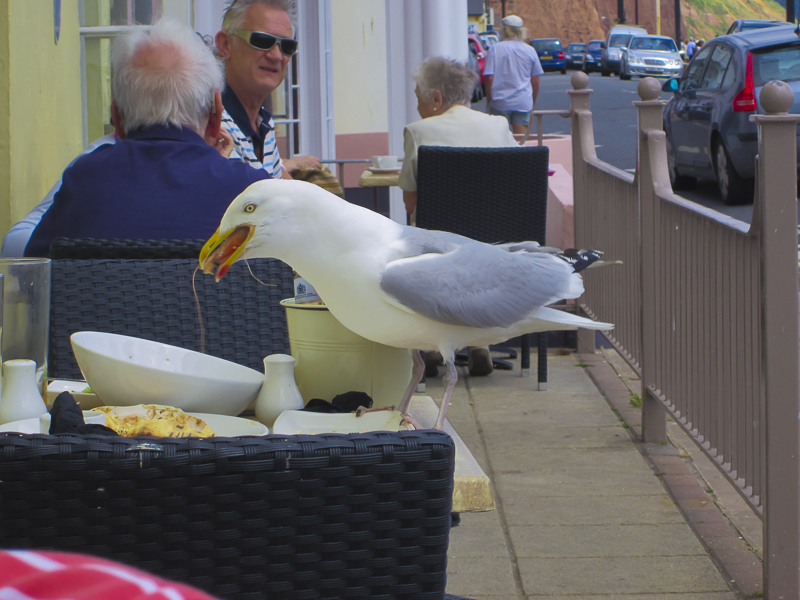The tender behaviour ritual displayed by a pair of city herring Gulls – Article by Andrew Gibb. Pics by Gray Clements.
Having purchased a small bottle of fruit juice, I walked from Sainsburys’ North Street exit, crossing the narrow pedestrian bridge which leads to a city centre multi-storey car park. A quick climb up the stairs took me to the topmost level and having negotiated the heavy swing door, I was out in the open once again. It was a beautiful sunny day, the warmest so far this year, with blue skies above the city and a spread of white cumuliform clouds layered across the distant vibrant green hilltops. This has got to be one of my favourite locations in Exeter. In spite of its close proximity to the centre of town, it is a place of relative calm and stillness affording magnificent views across the rooftops and chimneys. It is a place where you can lose yourself in quiet contemplation and a place where you can join the rooftop world of some of our great urban wildlife characters.
I positioned myself by the ‘far corner’ brick wall, looking out towards the spire of St. Michael and All Angels. Just in front of me, a small zebra spider made its ‘stop start, stop start’ ascent to the summit of the wall, traversing the bright orange-yellow lichen rosettes and clumps of dark green mosses which stood in its path. With its large pair of forward facing eyes, this is an ‘always alert’ hunter very much in tune with its environment, sensitive to the slightest of movements and ready to jump on unsuspecting prey.
A harlequin ladybird alighted on the wall several brick lengths away from the spider, whilst a busy metallic blue blow-fly, probably seeking a suitable site for depositing her eggs, explored a small pile of bird droppings situated towards the wall’s edge.
On outstretched wings and almost without effort it seemed, a herring gull appeared in front of me hanging in the air briefly before making a glide-by flight in the direction of the Guildhall. With a slight tilting of its body which caused right wing to be raised and left to be lowered, it arced high above the streets below, altering its course back towards the catacombs. There it joined the dozen fellows which soared and circled on the up currents, a subtle shift from greys to whites visible each time backs then bellies were presented to the sun. Is there a sight in nature more perfect?
A female herring gull flew down onto the low perimeter wall of the flat rooftop located the opposite side of the street. She stood still with her right leg held out awkwardly to one side, her weight supported for the most part by her left leg. After a short while she hopped down onto the roof and as she hobbled along, it was clear that she was carrying an injury. Her arrival prompted her partner to stand up, his head coming into view just above the top of the wall. Concealed in the shadows, this must be the site of their nest, the wall offering some protection against the elements.
The pair moved towards each other and a soft ‘klee-ew’ greeting call was made. The female touched her bill gently against his, encouraging him to disgorge food for her to consume. This ritual reinforces the pair bond and given the plight of this particular female, there is no doubting this behaviour will help to sustain her. Let’s hope she will be able to cope with the leg trauma and go on to raise her chicks successfully!
Meanwhile, a puddle of water next to the rooftop air conditioning units had attracted the attention of one of the local wood pigeons. It stood at the water’s edge, leaned forwards and began to drink. Having obtained its fill, it stepped forwards purposefully, promptly lowering its belly into the cooling waters. A picture of bliss in the hot sunshine!
A temporary lull in background traffic noise allowed for the incessant chirruping of the ‘Iron Bridge’ and Dinham Road house sparrows to carry, whilst the song of a male blackbird, the call of a blue tit and the ‘chyak’ of a jackdaw could also be heard. Three swifts with their scythe-like wings chased across the sky, their piercing ‘shreee’ screams adding a distinctive and most welcome layer to the urban soundscape.
A long, long way up in the sky, a pair of tiny silhouettes could just be seen with the naked eye. These were the ever watchful St. Michael peregrines soaring and gliding together in patrol of their territory. Now that their three chicks are large enough to retain body heat more readily, keeping each other warm by snuggling up together in the eyrie, the parents are able to leave the nest for longer periods of time. This is when the pair is at its most aggressive and this is when some quite spectacular behaviour can be witnessed above the rooftops of Exeter. A story to be continued in the next Nature Watch column!







by jenny steer
im pleased to hear that others share a love for gulls. i live in fleetwood and there is no other bird to match their beauty in flight my wife and i spend summer evenings with glass of wine watching their final acrobatics before settling down’